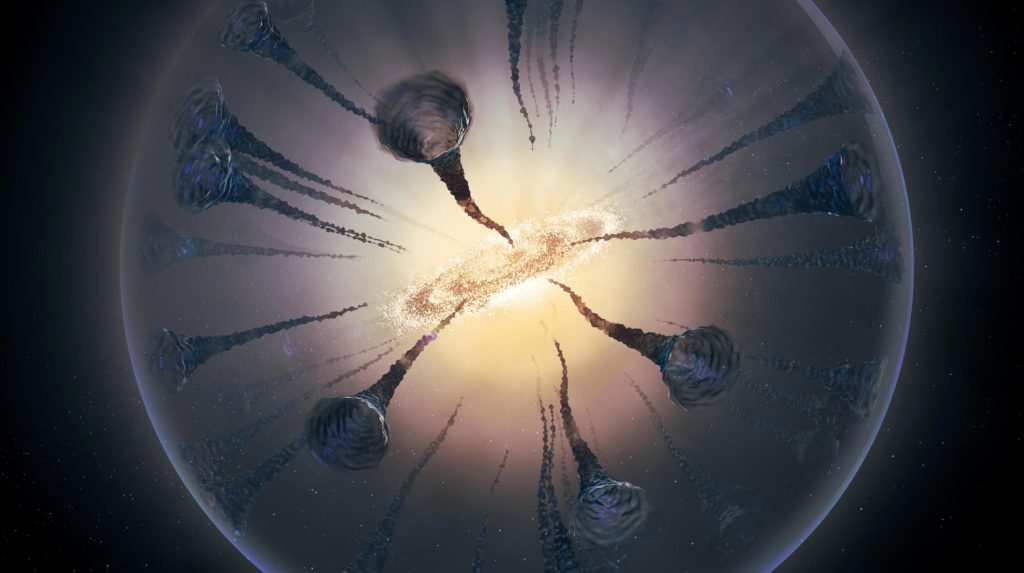Dark Matter & the Dalai Lama
Philosophers and Physicists
W
hen I first heard of Dark Matter,
I thought, this must be a joke … those physicists are at it again, conjuring up more fantastic tales. Turns out, it’s no joke, though it may contain approximately 90% humor.
The Physicist
They were all philosophers — could’ve been philosophy majors, but they chose physics — because they were interested in the grand scheme of things, what made things tick. They were some of the smartest dudes around. They wanted to know.
Science works with the visible, the known, the measurable.
When it comes to the invisible, the immeasurable, that gets relegated to the crypto, or pseudo-science realm, akin to faith or religion, what real scientists avoid — if they’re worth their salt.
But a strange, cryptic phenomenon has crept up over the years that has top physicists looking like children playing in a sand box. It’s called Dark Matter. It’s invisible to all of our instruments, can only be detected indirectly, and gives credence to the saying, ‘the more you know the less you know’.
Almost every day more news rolls in supporting a ‘Dark Matter Theory’. There’s also Dark Energy. Apparently we know little or nothing about 90% of everything.
“It’s as if we’re now going in to a 4th Copernican Revolution. The 1st Copernican Revolution was when we uncentered the Earth. People thought the Earth was the center and then we said, ‘no, the Sun is at the center’.
The 2nd Copernican Revolution was when we said ‘the Sun isn’t at the center either’; and the 3rd Copernican Revolution would be when we said ‘even the Galaxy isn’t at the center. The universe actually has no center’.
But now we’ve got to the point where not only are we not at the center, but the very stuff we are made of is only 10% of the stuff of the universe, and 90% of it is this ‘dark matter’ — and so we really want to know what that is.”
Where does science turn when roughly 90% of the stuff to measure is immeasurable? Philosophy?
The Philosopher
In an insightful book called The Universe in a Single Atom, the Dalai Lama recounts his meetings with renowned physicists of his day, and how he asked them to teach him the mysteries of physics— as they could — a young, Tibetan monk who had lost his home, but not his way.
In The Universe, he examines the concept of ‘the individual’ through a scientific lens, a Systems Perspective, redefining the nature of our assumed individuality with rare, interdisciplinary finesse.
Philosophers and physicists have the peculiar habit of not taking words at their agreed upon face value; they’re very much default linguists, and economists of logic.
When it comes to logic, the mild-mannered, 14th Dalai Lama is no slouch. As he sees it, we are “dependent arisings, empty of inherent existence.”
To unpack these strange words, simply, we do not come from ‘thin air’, but are a product of a specific context, a larger system, a complex environmental history which includes—among many other things—our parents, and their parents before them.
In the strictest logic, we are not independent as much as we are a part of something greater. He goes on to say that, it is to this greater system we owe our existence. As we could not exist without it, we could not inherently exist, and that any sharp, arbitrary bifurcation between our “selves” is inaccurate at best. At worst, a detriment to our species.
More than a logic puzzle; there are key implications.
We do not exist alone because we could not. We are the result, the flowering of what came before us. And what came before us, the result of what came before … truly, the grandest of all schemes. From this perspective, we are all linked together as one.
This correlates with the Entanglement Experiments of the 1930s, when Albert Einstein and quantum physicist, Erwin Schrödinger concluded that, even with our best instruments, we can’t look at any one piece of reality without disturbing the rest of it— as if everything were connected by an invisible thread we just can’t see (a theme paralleled by Bronze Age, Vedic texts).
Neither Einstein nor Schrödinger were comforted by their findings, Einstein called it “Spooky action at a distance”. I can only assume that, by “spooky”, he meant it was difficult to move beyond the lingering effects of the reductionist Newtonian Model. Perhaps Dark Matter and Energy act as a non-linear, non-local connective tissue that makes this instant communication possible.
Any claim to individual independence is a “localized” experience — an emergent, subjective illusion of consciousness. In the big picture, the objective picture, we are anything but independent.
If we can’t do something without affecting everything, what does this say about the practical, everyday world?
If a measure of my kindness — or my distrust — affects the person next to me, and theirs the next, this immeasurable quality would not show up on a CT scan or physical examination of our bodies. But it’s there. And the effects are far-reaching. In the unseen nuts and bolts of reality we’re all so intimately and eschatologically connected as to be one thing. We need to reassess the viability of possession, contention, war. War with ourselves?…
For Appearance’ Sake
The physicist works to bring us the truth of the world in spite of traditional beliefs or appearances — a daunting task. And I am grateful, and thankful physicists don’t suffer at the hands of the establishment as they used to, were they to discover something that undermined the narrative dictated by the powers at be. The truth can now be told. And may the physicist continue to wake the world to a better understanding of reality.
“If we really want to try and understand what this extraordinary universe really is like we just have to look at what is the best current picture that science is giving us and recognize that it’s changing all the time.”
Quantum Theory is the most up to date, successful scientific theory going, and the reason we’re able to connect with each other via the digital world. Physics tells us that appearances are deceiving, and that we are, and always have been connected — as brothers and sisters — we are all one family, made of matter. Admittedly it is hard to hear over the din of cultural materialism and distraction.
At the atomic scale, what is done to the least of our society is done to us. I wonder when our culture will catch up to this empirical truth—and leave appearances behind?
Every person is as important as the next in the Grand Scheme: a product of the individual actions of each individual person — that ever lived — and each event in the cosmos that ever happened, which led to this moment on a collective wave of action through ephemeral time and space in a sort of butterfly effect. Everything affects everything. We cannot afford to externalize anyone or anything for the sake of appearance — which cannot be relied upon.
“We’re all connected whether we like it or not, and it is unthinkable to be happy all by oneself”.
We know so little about what’s going on it’s phenomenal in itself we can find the time to squabble — precious time lost for discovering just who we are and what makes things tick+


Thank you to Markos Kay, for your brilliant illustration, and to the water-colorist, for yours.

